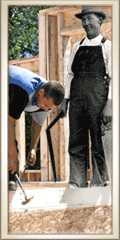|
|||
|
Now Over 25,000 Categorized Links! Family Census Data Directory |
|
|||
|
Now Over 25,000 Categorized Links! Family Census Data Directory |
|
|

|
1920 CensusGo to available databases for 1920The 1920 census was begun on 1 January 1920. The enumeration was to be completed within thirty days, or two weeks for communities with populations of more than 2,500. Questions Asked in the 1920 Census Name of street, avenue road, etc.; house number or farm; number of dwelling in order of visitation; number of family in order of visitation; name of each person whose place of abode was with the family; relationship of person enumerated to the head of the family; whether home owned or rented; if owned, whether free or mortgaged; sex; color or race; age at last birthday; whether single, married, widowed, or divorced; year of immigration to United States; whether naturalized or alien; if naturalized, year of naturalization; whether attended school any time since 1 September 1919; whether able to read; whether able to write; personís place of birth; mother tongue; fatherís place of birth; fatherís mother tongue; motherís place of birth; motherís mother tongue; whether able to speak English; trade, profession, or particular kind of work done; industry, business, or establishment in which at work; whether employer, salary or wage worker, or working on own account; number of farm schedule. Other Significant Facts about the 1920 Census The date of the enumeration appears on the heading of each page of the census schedule. All responses were to reflect the individualís status as of 1 January 1920, even if the status had changed between 1 January and the day of enumeration. Children born between 1 January and the day of enumeration were not to be listed, while individuals alive on 1 January but deceased when the enumerator arrived were to be counted. Unlike the 1910 census, the 1920 census did not have questions regarding unemployment, Union or Confederate military service, number of children, or duration of marriage. It did, however, include four new question columns: one asked the year of naturalization and three inquired about mother tongue. The 1920 census also asked the year of arrival and status of every foreign-born person and inquired about the year of naturalization for those individuals who had become U.S. citizens. In 1920 the census included, for the first time, Guam, American Samoa, and the Panama Canal Zone. Also unlike the 1910 census, the 1920 census has a microfilmed index for each state and territory. Due to boundary modifications in Europe resulting from World War I, some individuals were uncertain about how to identify their national origin. Enumerators were instructed to spell out the name of the city, state, province, or region of respondents who declared that they or their parents had been born in Germany, Austria-Hungary, Russia, or Turkey. Interpretation of the birthplace varied from one enumerator to another. Some failed to identify specific birthplaces within those named countries, and others provided an exact birthplace in countries not designated in the instructions. See Department of Commerce, Bureau of the Census, Fourteenth Census of the United States, January 1, 1920: Instructions to Enumerators (Washington, D.C.: Government Printing Office, 1919). There are no separate Indian population schedules in the 1920 census. Inhabitants of reservations were enumerated in the general population schedules. Enumerators were instructed not to report servicemen in the family enumerations but to treat them as residents of their duty posts. The 1920 census includes schedules and a Soundex index for overseas military and naval forces. Soundex cards for institutions are found at the end of each stateís Soundex index. It is important to note that many institutions, even if enumerated at their street addresses, are found at the end of the enumeration section. The original 1920 census schedules were destroyed by authorization of the Eighty-third Congress, so it is not possible to consult originals when microfilm copies prove unreadable. Research Tips for the 1920 Census Since nearly everyone has some knowledge or access to knowledge of family names, relationships and the familyís state of residence in 1920, most genealogical instructors recommend the 1920 census as the best starting point for research in federal records. Working from known information about the most recent generations, an efficient researcher works backwards in time to discover family relationships and to determine where additional records may be found. The 1920 census is a good tool for determining approximate dates and places to search for marriage records, birth and death records of children, and the marriages of children not listed. The 1920 census sometimes makes it possible to verify family traditions, identify unknown family members, and link what is known to other sources, such as earlier censuses, school attendance rolls, property holdings, and employment and occupational records. In several instances, women, rather than men, have been listed as head of household in the 1920 Soundex index (figure 5-3); therefore, a search focused on a male name may be unsuccessful. The 1920 census asked the foreign-born for the year of their arrival in the United States, making it easier to pinpoint the date of passenger arrival records. It also asked the naturalization status of every foreign-born person and inquired about the year of naturalization for those individuals who had become U.S. citizens, thus facilitating searches in naturalization records. Due to the more specific questions asked of immigrants from Germany, Austria-Hungary, Russia, and Turkey regarding their birthplaces and those of their parents, many researchers will be able to discover the exact towns or regions from which their families emigrated. The fact that the 1920 census asked for the mother tongue of each respondent and that of each parent will further help to define the origins of many families. Go to available databases for 1920
|
|